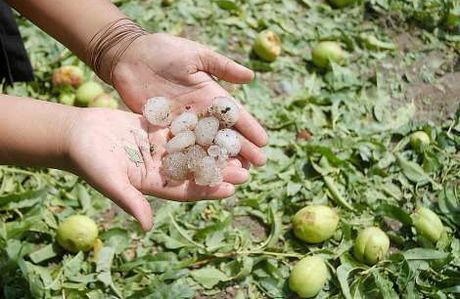 w months different hailstorms have left a trail of destruction in Europe. The harvests in various countries were affected by the bad weather. In order to get a picture of the extent of the damage, the following gives an overview of the affected areas over the last few months:
w months different hailstorms have left a trail of destruction in Europe. The harvests in various countries were affected by the bad weather. In order to get a picture of the extent of the damage, the following gives an overview of the affected areas over the last few months:Spain
In January greenhouses in Motril were under a layer of snow and hail. A month later the strawberry harvest in the Canary Islands was damaged by various hailstorms. Open ground, in particular, has been affected. Where there was once 300,000 strawberry plants in the area, there are now only 200,000. The affected area is around 40 ha.
In April the Fraga region was affected with heavy rain and hailstorms in which 20 to 30 liters (per square meter) of water fell. More than 500 ha of apricots, peaches, cherries and nectarines were damaged. The entire affected area is around 600 - 800 ha.
In June there were hailstorms in various regions in Spain, including Costera and Ribera. The hail caused damage to 500 hectares, affecting citrus and khaki. 70% of the harvest was damaged.
In Valencia 45,000 ha were affected by hail. Eyewitnesses reported hailstones the size of golf balls. 60 - 80% of the crops were affected, in particular citrus, khaki's, melons, and watermelons.
In Murcia 12,000 ha were affected by the hail, especially stone fruit, and to a lesser extent, grapes. The final damage to the fruit was not too bad due to the fact that most of the stone fruit was already harvested. Only yellow peaches and nectarines were hit. The damage to grapes was also not that bad because this harvest is protected with nets.
Greece
Estimates for the Greek top fruit production in January were downgraded due to the bad weather conditions during the growing season. The apple harvest will, as expected, fall 10% and the volume of pears will decrease 26%.
A hailstorm affected the Veria region in June and damaged the peach and apricot harvests. The damage is estimated (initially) around 80 to 100% of the peach crop in Veria, Meliki, Makrychori and Vergina. The affected area is 15 km long and 15 km wide. The damage falls between 40,000 to 50,000 tons, approximately 10% of total Greek production.
Italy
A warning was issued in March in Italy for hail and cold, that could damage the crops. After the warm winter the crops developed further than normal. A cold front can cause a lot of damage.
In April Italy had bad weather and this caused damage in various regions throughout the whole country. Kiwis, melons and watermelons, peaches and apples belong to the affected crops. Rain, hail and wind are responsible for the damage.
After a period of drought, there came heavy storms and hailstorms in June throughout the country. In one of the affected areas, east of Bologna, 70 mm of rain fell in some places. Crops in open fields and in the greenhouse were damaged, including potatoes and onions, but also fruit in different stages of maturity were hit.
The Netherlands
In April and May heavy thunderstorms fell over the Betuwe, Bommelerwaard and Northeast. Hundreds of hectares of top and soft fruit were hit, but also onion and cauliflower growers reported to the insurance companies. The damage in Gelderland is estimated at 10,000 euros a hectare. A grower in Gelerland lost his entire cherry, pear and apple harvest.
Central Europe
After floods come hailstorms which increases the damage. In Germany a loss of between 4 to 5 million euros has been reported. In Switzerland it was 2 million. As well as greenhouses, open ground vegetables were also affected by hail damage. A greenhouse company reported a loss of one and a half million euros after hail destroyed half of the roof.
France
In June two hailstorms fell over the Ile-de-France and caused a lot of damage for the agricultural sector. The whole harvest of a few fruit and vegetable growers was lost. Damage to the hardest hit growers runs up to 500,000 euros. Greenhouses were also damaged. On top of damage to the glass, harvests under the glass are lost as well. The bad weather caused damage in orchards as well.
Although it seems as if the weather is getting more extreme, much remains unclear about the link between climate change and this weather. The KNMI reports that the chance of extreme weather has increased and it is very likely that this trend will continue.





